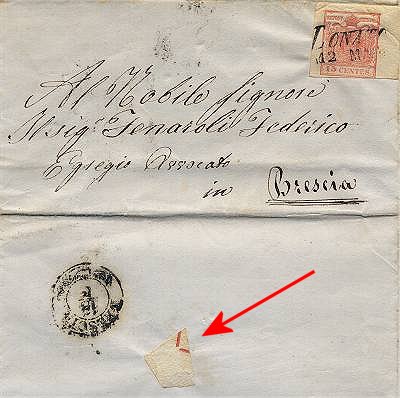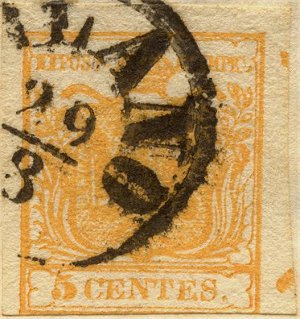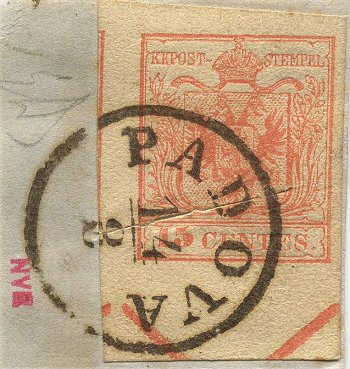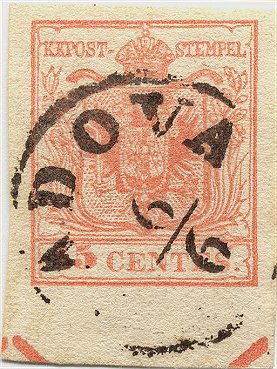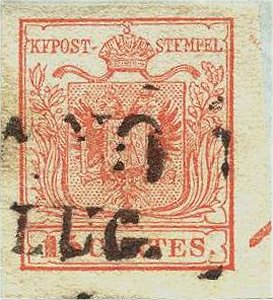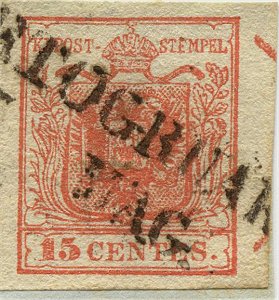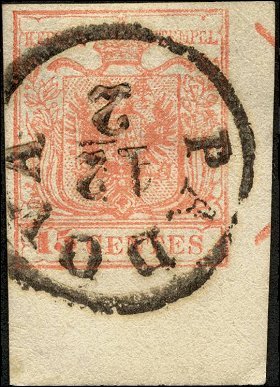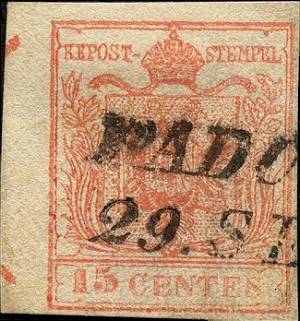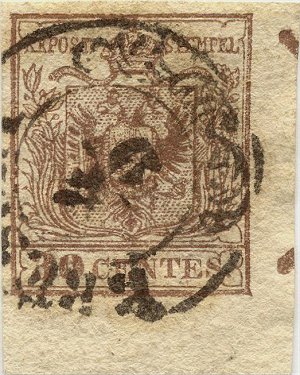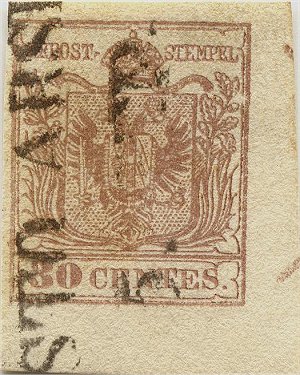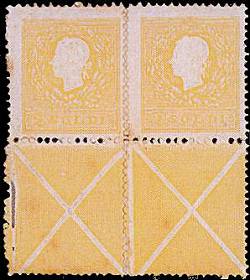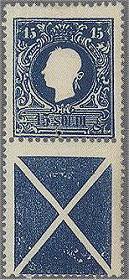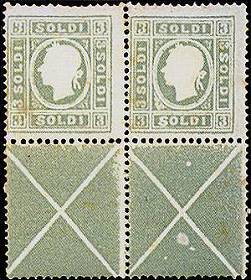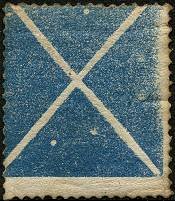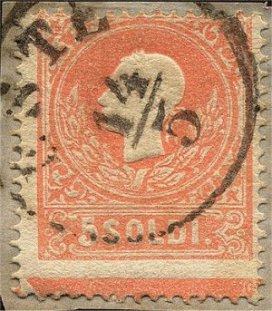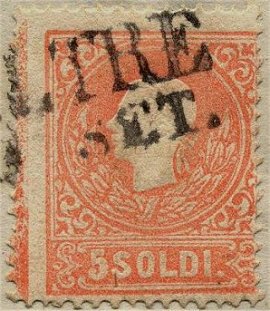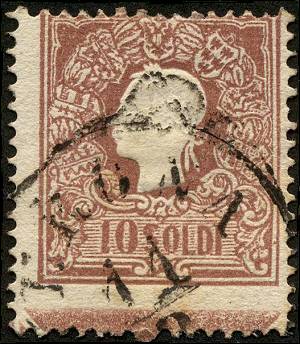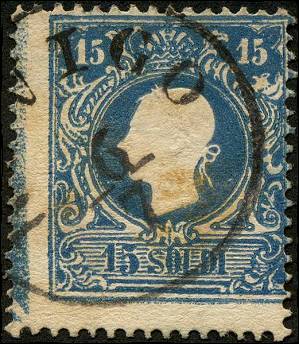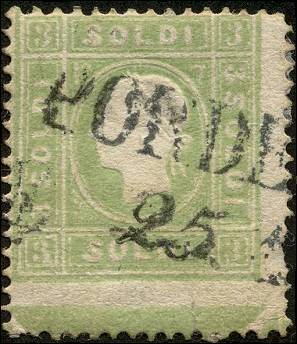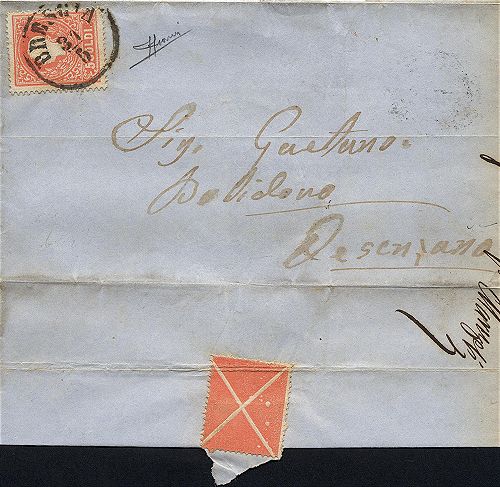The
"S. Andrew Cross"
I
said in the general introduction of the first and second issues that the sheets
of stamps presented in the last row not 8 stamps like in the previous rows
but 4 stamps and 4 S. Andrea's Crosses, in substance 4 big "X" in
place of the stamps.
To understand the reason of the presence of these Crosses we have to make
a step back: the stamps in use in Lombardy-Venetia were the same used in Austria;
they differ only for the indication of the value, in Centesimi the "Italian"
ones, in Kreuzers the "Austrian".
The Crosses have been inserted to simplify the calculation of the value of
the Austrian sheets. Each sheet of stamps was composed by 240 samples, divided
in 4 groups of 60 pieces (two groups at top and two groups at bottom) each
quarter was made by seven rows of 8 stamps plus the last row with only 4 stamps.
The result was that each quarter contained 60 stamps (7x8 + 4 = 60). The Austrian
currency was at that time the Fiorino (or Gulden) that was composed,
strangely enough, by 60 Kreuzers. For that reason each quarter of "Austrian"
stamps had exactly that value in Fiorini of the printed stamp. For instance
the value of a quarter of the sheet of 1 Kreuzer was 1 Fiorino (60 pieces
of 1 Kreuzer were 60 Kreuzers, that means 1 Fiorino), the value of a quarter
of a sheet of 6 Kreuzers was 6 Fiorini (60 pieces of 6 Kreuzers were 360 Kreuzers
that is 6 Fiorini...) and so on. This solution made very fast the calculation
of the sheets in stock, avoiding complex mathematical operations (the calculators
were far away to be invented...).
This system made quite simple also the calculation of the values in centesimi
(even if this is probably due by accident from the moment that the Crosses
have been designed for the calculation of the stamps in Kreuzers); each quarter
had a value that was expressed with a whole number avoiding the centesimi.
As said, the Crosses were kept also for the second issue, with the only clear
reason to allow for calculations with numbers always multiple of 10 and easy
to be summed in the administrative calculations.
I summarize here the scheme of the values of the quarters of sheet both Austrian
as well as Italian.
|
Quarter
sheet of the 1 Kreuzer
|
= 1 Fiorino
|
|
Quarter
sheet of the 3 Kreuzer
|
=
3 Fiorini
|
|
Quarter
sheet of the 6 Kreuzer
|
=
6 Fiorini
|
|
Quarter
sheet of the 9 Kreuzer
|
=
9 Fiorini
|
|
Quarter
sheet of the 5 centesimi
|
=
3 Lire
|
|
Quarter
sheet of the 10 centesimi
|
=
6 Lire
|
|
Quarter
sheet of the 15 centesimi
|
=
9 Lire
|
|
Quarter
sheet of the 30 centesimi
|
=
18 Lire
|
|
Quarter
sheet of the 45 centesimi
|
=
27 Lire
|
|
Quarter
sheet of the 2 Soldi
|
=
120 Soldi
|
|
Quarter
sheet of the 3 Soldi
|
=
180 Soldi
|
|
Quarter
sheet of the 5 Soldi
|
=
300 Soldi (or 3 Fiorini)
|
|
Quarter
sheet of the 10 Soldi
|
=
600 Soldi (or 6 Fiorini)
|
|
Quarter
sheet of the 15 Soldi
|
=
900 Soldi (or 9 Fiorini)
|
There
it is explained the S. Andrea's Crosses mystery: asimple but clever accounting
simplification.
Let's now look at them in detail. The disposition of the Crosses in the various
quarter sheets was of three types, even if we cannot exclude different others.
I show them here below (Fig. 1, 2, 3); the Crosses are made evident
in red:
 |
 |
|
|
Fig.
1: the first possible disposition
|
Fig.
2: the second possible disposition
|

Fig. 3: the
third possible disposition
